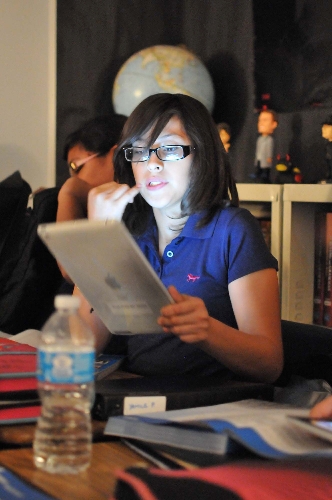School district hands out free iPads to students at five low-income middle schools

It was dark inside Khara Barnard’s classroom. Glimmers of yellow and red light from several campfires helped illuminate it. The hisses and pops of the burning wood filled the air with sound while students read an excerpt from author Cynthia Kadohata’s novel "Kira-Kira."
There were no real campfires but rather digital ones displayed on students’ iPads. It is an example of how creative teachers are getting with new technology.
Barnard is an English teacher at Garside Middle School, 300 S. Torrey Pines Drive, one of five low-income middle schools to get a huge technology boost this year.
Each of Garside’s 1,200 students received a free iPad to use while enrolled at the school. Students can use them in class and take them home and on trips. The iPads are part of the Clark County School District’s e3: Engage, Empower, Explore Project. The district expects the initiative to increase student achievement.
Along with Garside, participating middle schools are Martin, 200 N. 28th St.; Sedway, 3465 Englestad St.; Bridger, 2505 N. Bruce St.; and Von Tobel, 2436 N. Pecos Road.
The iPads were paid for with Title I grant funding, with no money coming from the school district’s general fund. Title I funds are federal dollars used to improve academic achievement among at-risk students.
Before a student could receive an iPad, parents or guardians had to sign a waiver holding them financially responsible for damage to it. The district installed anti-theft software on each device that will send its location to the Clark County School District Police Department if it is reported stolen. Students also received thick rubber cases and screen protectors.
The district tested an iPad pilot program last school year, with about 1,150 students at four schools —- Silvestri and Leavitt middle schools, Silverado High School and the Academy for Individualized Study —- receiving devices.
Garside sixth-grader Yamile Piedra did not have a working computer at home before getting her iPad. She has always liked school anyway, Yamile said, but added that the iPad makes it better.
"I like it because it helps me learn more," she said.
Pencils, paper and books have become nearly obsolete. Yamile said she can type essays in class faster than she could write them and with less pain in her hands. She takes all of her notes and tests digitally and accesses textbooks, submits homework and can communicate with classmates or teachers through different applications.
Her classmate, Brian Preciado, said his choir class uses the iPads to read digital sheet music. In physical education, students used iPads to get warm-up exercises and track their progress.
"I’m quite happy to have it everywhere for every single student," said Garside’s principal, Scarlett Perryman. "From my end, it’s pleasing to watch the teachers make appropriate use of technology and find innovative ways to engage students. It’s a fabulous engagement tool."
Garside trained 20 students as technology aides to students and parents with questions before school or during lunch.
Perryman said lunchtime has become "quite enjoyable," as students are "very focused and "very interactive" with each other on iPads. Students are allowed to play approved games on the iPad during lunch, and some teachers allow students to play instructional games in subjects such as math, as long as they are learning while they play.
Contact View education reporter Jeff Mosier at jmosier@viewnews.com or 224-5524.